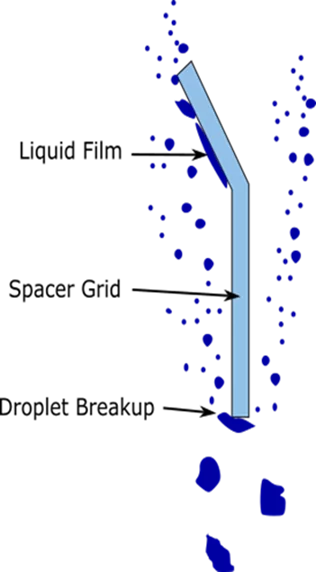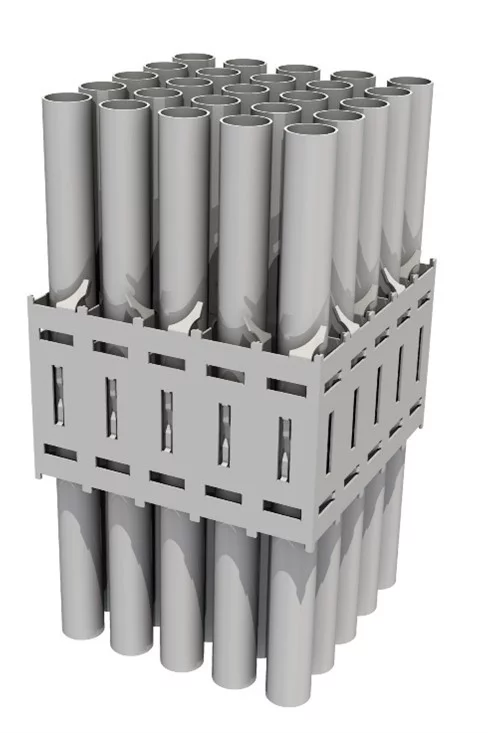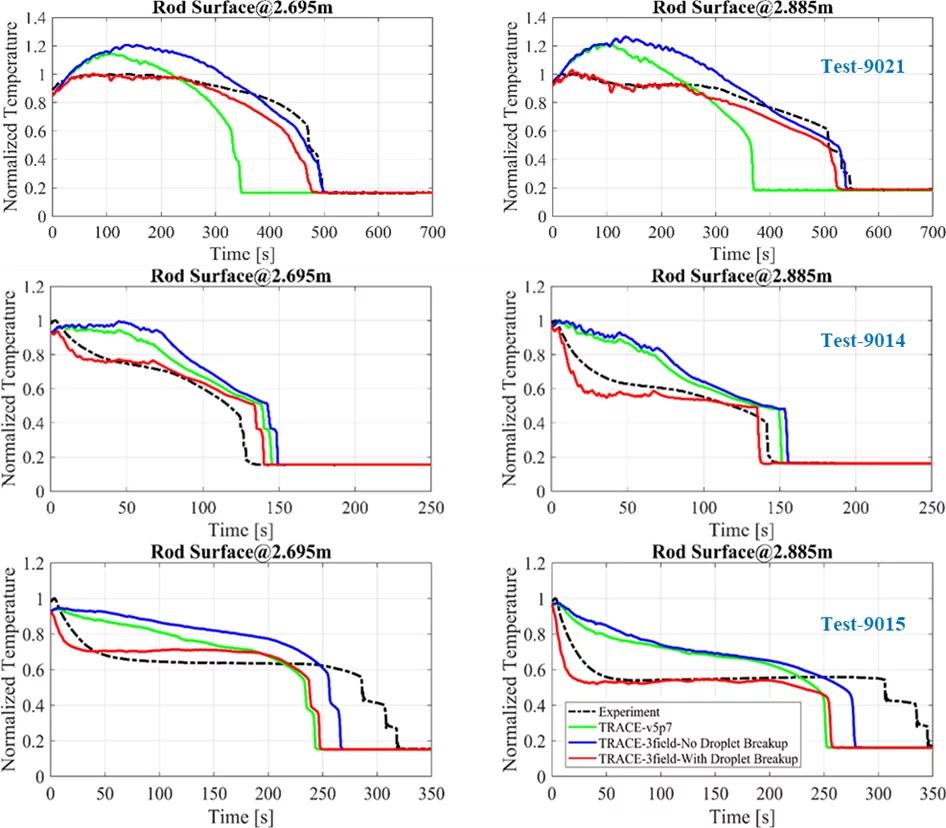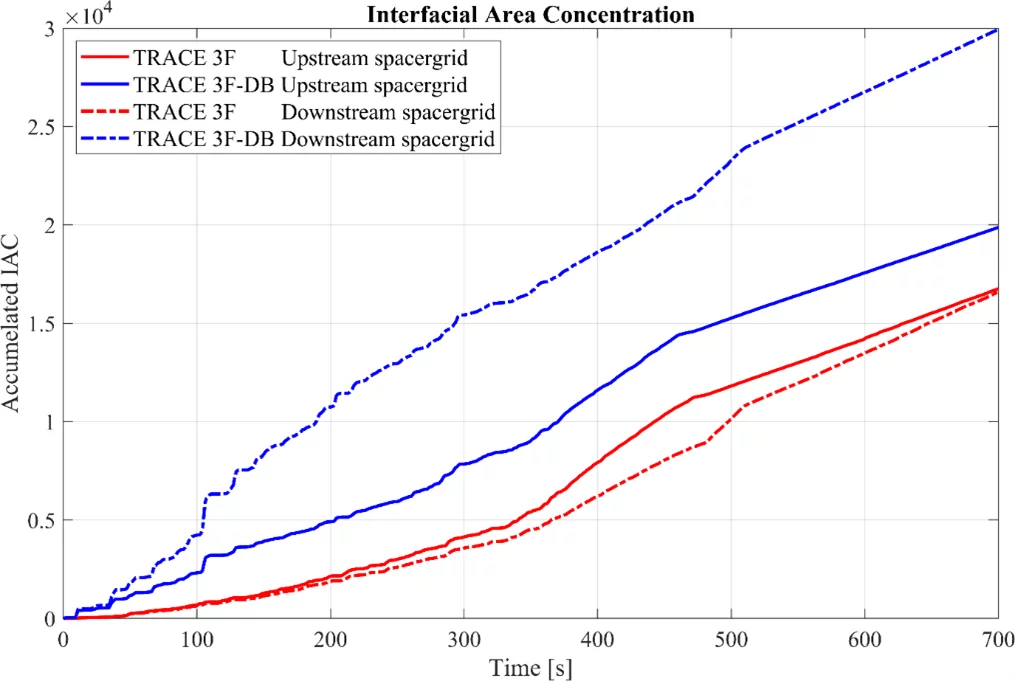For water-cooled nuclear reactors, a loss of coolant accident constitutes one of the key scenarios to be evaluated for the design of the plant and associated safety systems. Even if these accidents are not expected to occur at all during reactor lifetime, their potential consequences include the heat up of the fuel in the reactor core. For the recovery of the plant to safe conditions, safety systems are in place to inject water in order to reflood the core and to quench the high temperature fuel. The two-phase flow behaviour during this reflooding phase is extremely complex. In particular, the prediction of the behaviour of small liquid droplets generated as the quench front propagates upwards has a significant effect on the fuel temperatures in the upper regions of the reactor core. In collaboration with the US Nuclear Regulatory Commission (NRC), we have been working to improve our modelling of the droplet behaviour and their impact on key safety parameters.

Background
Nuclear reactors are designed and built to stay safe and operational during any event. Even if something unexpected occurs, such as losing coolant inventory, the emergency core cooling system (ECCS) is activated to keep the reactor safe. The ECCS injects water into the reactor to reflood the core and prevent the fuel rods from being damaged due to overheating. During reflood, the water flows upwards into the reactor core, forming a quench front that progressively cools the rods. Understanding the propagation of the quench front and the two-phase flow behaviour during reflood is important for the safety and licensing of nuclear reactors.
Researchers in the area of nuclear reactor safety use advanced computer simulation codes such the US Nuclear regulatory Commission (NRC) code TRACE to simulate different situations at nuclear power plants. We are continuously working to improve these codes and increase the accuracy of our predictions. TRACE acts as a simulator, helping us to understand the response of the reactor under different conditions and during different postulated scenarios. During the OECD/NEA Rod Bundle Heat Transfer (RBHT) international collaborative project, researchers found that several computer simulation codes, including TRACE, consistently overpredicted the fuel rod surface temperatures in comparison to the experimental data. Further investigations at PSI showed that the root cause was a fundamental deficiency in the closure models of TRACE. In particular, TRACE used too simple an approach to capture the behaviour of the liquid droplets as they are carried upwards during reflood and their interactions with the spacer grids. Spacer grids (shown in Figure 1) are an integral part of the fuel assemblies that ensure a consistent spacing between the individual fuel rods, protect the fuel rod from the vibrations caused by the flowing water, and to induce turbulence in the coolant flow to improve cooling efficiency.

Figure 1 Light water reactor spacer grid
An interesting effect of these grids during reflood is that they interrupt the upward flow of liquid droplets, potentially causing them to “shatter” and break up into multiple smaller droplets. The smaller droplets lead to more efficient cooling downstream of the spacer grids. To estimate the shattered droplet diameter, several empirical models have been developed over the years, taking into account the flow conditions, the structure of spacer grids, and the thickness of the grids.
Modelling of Droplet Behaviour
In a collaborative development with the code developers at the US NRC, PSI have worked towards improving the modelling of the droplet behaviour in the TRACE code. Traditionally, TRACE separates the coolant within each region of the reactor into either liquid or vapour fields. More recently, the code developers introduced a dedicated field for the droplets, opening the path towards more physically consistent modelling of the interaction between the droplets and the spacer grids. This modification has significantly enhanced the predictive capabilities of TRACE in certain flow conditions. Updated simulation results showed a remarkable improvement in the prediction of the quench propagation for low and medium reflood rate tests. The maximum temperature of the metallic cladding around each fuel rod, the so-called peak cladding temperature (PCT), was still significantly overestimated, however. It was postulated that this was due to the lack of droplet breakup mechanisms in the code. PSI therefore took the lead on the development and implementation of closure models for the droplet breakup in the presence of spacer grids.
Model assessment
For the assessment of the newly implemented models, experimental results from the OECD/NEA RBHT project were used. Selected cases are summarized in Table 1. We compared the predicted outcomes generated by three different versions of TRACE: The standard release version of TRACE (v5p7), a three-field development version of TRACE without droplet breakup (3F), and PSI’s development version of TRACE including droplet breakup (3F-DB).
Table 1 Boundary conditions for some of RBHT experiments
Test | Reflood Rate (cm/s) | Water Temperature (°C) | Budle Power (kW) |
|---|---|---|---|
9014 | 15 | 25 | 252 |
9015 | 15 | 90 | 252 |
9021 | 2.5 | 90 | 144 |
In the initial analysis of test 9021, as illustrated in Figure 2, conducted at a low reflood rate and low water temperature, we observed consistent trends in rod surface temperatures at two specific axial positions (2.695 m and 2.885 m from the inlet) across all three simulations. However, variations are evident in the maximum rod surface temperature and quenching time. Prior to quenching, both TRACE v5p7 and TRACE 3F tend to overestimate rod surface temperatures, while TRACE 3F-DB shows improved predictive accuracy. Furthermore, both TRACE 3F and 3F-DB provide more precise estimates of quenching time compared to TRACE v5p7, with a difference of around 150 seconds. Tests 9014 and 9015 share similar operational parameters, including an inlet velocity of approximately 15 cm/s, peak power of 2.30 kW/s, however, the injected water temperatures are 25 °C and 90 °C, respectively. Figure 2 reflects transient behaviour, with test 9014 exhibiting a more rapid response due to its lower inlet temperature. When using TRACE 3F-DB, accurate predictions of rod surface temperature at various axial positions are observed for both test cases, primarily influenced by the droplet breakup model. At the start of each test, TRACE 3F-DB effectively captures the immediate decrease in rod surface temperature. However, both TRACE v5p7 and TRACE 3F tend to overestimate the maximum rod temperature for both tests. The findings indicate a substantial improvement in heat and mass transfer due to the inclusion of droplet field and breakup models. Specifically, the results highlight the importance of incorporating the droplet breakup model to enhance the accuracy of predicting reflood phenomena.
The phenomenon of droplet breakup has a substantial impact on heat and mass transfer within the rod bundle. The breakup results in many smaller-diameter droplets, thereby increasing the surface area between liquid phase and vapor phase i.e., interfacial area concentration (IAC). As shown in Figure 3, TRACE 3F-DB estimates a higher total IAC compared to TRACE 3F. As estimated, the IAC in TRACE 3F-DB substantially increases downstream of the spacer grid due to droplet breakup. In contrast, without droplet break, TRACE 3F we see a reduced IAC downstream of the spacer grid, which is physically inconsistent.

Figure 2 Evolution of RBHT rod surface temperature during reflood test

Figure Figu 3 The influence of spacer grid droplet breakup on the Interfacial Area Concentration (IAC) during reflood test
Future Work
We are continuing to collaborate with the US Nuclear Regulatory Commission to develop and further improve TRACE. Our key area of focus is still on the behaviour of droplets, and we are now focusing on modelling multiple fields of droplets so we can better capture the distribution of droplet sizes and their temperatures. These improvements will help us to get better estimates of several parameters such as the pressure inside the reactor core and how much liquid is carried along with the steam going out from the reactor core.
Contacts
Omar Al-Yahia
Principal Investigator
omar.alyahia@psi.ch
Ivor Clifford
Group Leader System Behaviour
ivor.clifford@psi.ch
Selected Publications
- Al-Yahia, OS.; Bernard, M.; Clifford, I.; Perret, G.; Bajorek, S.; Ferroukhi, H. The influence of droplet breakup model on the prediction of reactor core parameters during reflood conditions. Nuclear Engineering and Design. 416, 2024, 112815. https://doi.org/10.1016/j.nucengdes.2023.112815
- Bernard, M.; Bajorek, S.M. Implementation of a Three-Field Framework in TRACE to Improve the Prediction of Reactor Core Reflood Conditions Part I. 20th International Topical Meeting on Nuclear Reactor Thermal Hydraulics (NURETH-20), (2023, August 20–25, 2023). Washington, D.C
- Jin, Y.; Cheung, F.-B.; Shirvan, K.; Bajorek, S. M.; Tien, K.; Hoxie, C. L.. Development of a droplet breakup model for dry spacer grid in the dispersed flow film boiling regime during reflood transients. International Journal of Heat and Mass Transfer. 2019, 143, 118544. https://doi.org/https://doi.org/10.1016/j.ijheatmasstransfer.2019.118544
- Perret, G.; Clifford, I.; Ferroukhi, H. Bias and uncertainty considerations for trace predictions of RBHT reflood experiments. 19th international topical meeting on nuclear reactor thermal hydraulics (NURETH-19), March 6-11, 2022. Brussels.

